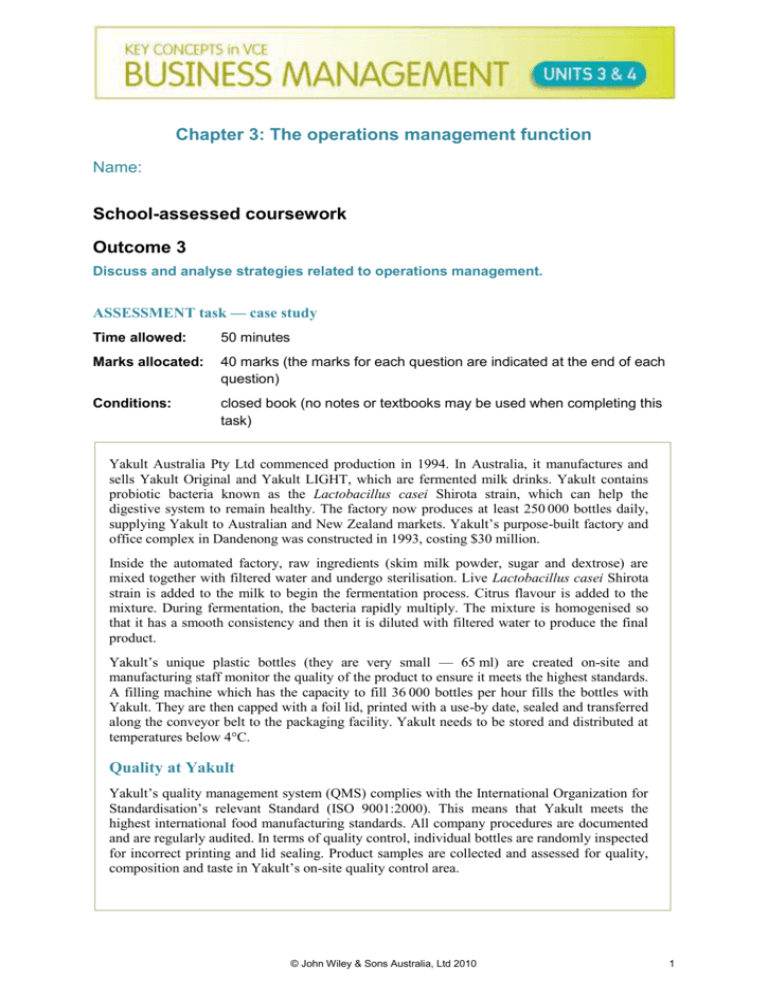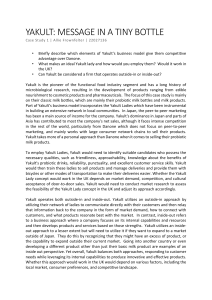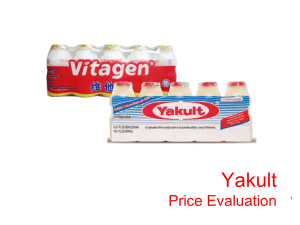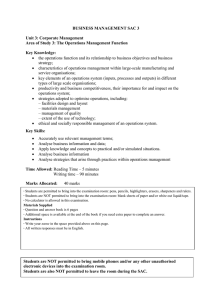Chapter 3: The operations management function
advertisement

Chapter 3: The operations management function Name: School-assessed coursework Outcome 3 Discuss and analyse strategies related to operations management. ASSESSMENT task — case study Time allowed: 50 minutes Marks allocated: 40 marks (the marks for each question are indicated at the end of each question) Conditions: closed book (no notes or textbooks may be used when completing this task) Yakult Australia Pty Ltd commenced production in 1994. In Australia, it manufactures and sells Yakult Original and Yakult LIGHT, which are fermented milk drinks. Yakult contains probiotic bacteria known as the Lactobacillus casei Shirota strain, which can help the digestive system to remain healthy. The factory now produces at least 250 000 bottles daily, supplying Yakult to Australian and New Zealand markets. Yakult’s purpose-built factory and office complex in Dandenong was constructed in 1993, costing $30 million. Inside the automated factory, raw ingredients (skim milk powder, sugar and dextrose) are mixed together with filtered water and undergo sterilisation. Live Lactobacillus casei Shirota strain is added to the milk to begin the fermentation process. Citrus flavour is added to the mixture. During fermentation, the bacteria rapidly multiply. The mixture is homogenised so that it has a smooth consistency and then it is diluted with filtered water to produce the final product. Yakult’s unique plastic bottles (they are very small — 65 ml) are created on-site and manufacturing staff monitor the quality of the product to ensure it meets the highest standards. A filling machine which has the capacity to fill 36 000 bottles per hour fills the bottles with Yakult. They are then capped with a foil lid, printed with a use-by date, sealed and transferred along the conveyor belt to the packaging facility. Yakult needs to be stored and distributed at temperatures below 4°C. Quality at Yakult Yakult’s quality management system (QMS) complies with the International Organization for Standardisation’s relevant Standard (ISO 9001:2000). This means that Yakult meets the highest international food manufacturing standards. All company procedures are documented and are regularly audited. In terms of quality control, individual bottles are randomly inspected for incorrect printing and lid sealing. Product samples are collected and assessed for quality, composition and taste in Yakult’s on-site quality control area. © John Wiley & Sons Australia, Ltd 2010 1 Chapter 3: The operations management function Waste management Yakult Australia is very much aware of the need to minimise its environmental impact. Its waste management strategies, such as recycling of paper products and plastic waste, have resulted in more than 99 per cent of raw ingredients being utilised. Cleaning waste goes into a holding tank in the on-site water treatment facility. 1 Define the following terms using examples from the Yakult case study: product layout inventory control automation. 3 × 2 = 6 marks 2 Outline the inputs used by Yakult. 2 marks 3 Describe the output of Yakult. 2 marks 4 Identify and explain three considerations that would have been taken into account when Yakult planned the factory layout. 6 marks 5 What are the main differences between the operations of a manufacturer and a service provider? Which category does Yakult fit under? 4 marks 6 Explain what materials management is about. Describe all of the materials which Yakult needs to manage. 4 marks 7 Discuss the benefits to Yakult of using Materials Requirements Planning (MRP). 4 marks 8 Describe two quality strategies used at Yakult. 4 marks 9 Outline another quality strategy which could be used by Yakult. 10 4 marks Explain how Yakult has incorporated social responsibility into its operations system. 4 marks © John Wiley & Sons Australia, Ltd 2010 2










